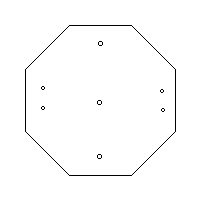 To build our first robot, we'll use 0.125 inch thick plexiglass. The idea we got from The Robot Builder's Bonanza found here. The octogon is a 6in. by 6in. base. The corners were measured and cut 2 inches in from either side. For the center holes, we used a 3/16 (#10) bit. These are 1 inch in and dead center, respectively. The holes in the sides were made with a 7/32 (#19) bit. These are 1 inch in and 1 inch apart. If you've purchased The Robot Builder's Bonanza like we did, you'll notice that they do leave out some key points to the design process. This is so you can figure out how to design or learn to design your own robots. We came up with two different alternatives as to how to finish what they started. You can use what we've done or take what we have and make your own alternatives. Either way, you can't go wrong as long as you stick to some of the key design aspects.
To build our first robot, we'll use 0.125 inch thick plexiglass. The idea we got from The Robot Builder's Bonanza found here. The octogon is a 6in. by 6in. base. The corners were measured and cut 2 inches in from either side. For the center holes, we used a 3/16 (#10) bit. These are 1 inch in and dead center, respectively. The holes in the sides were made with a 7/32 (#19) bit. These are 1 inch in and 1 inch apart. If you've purchased The Robot Builder's Bonanza like we did, you'll notice that they do leave out some key points to the design process. This is so you can figure out how to design or learn to design your own robots. We came up with two different alternatives as to how to finish what they started. You can use what we've done or take what we have and make your own alternatives. Either way, you can't go wrong as long as you stick to some of the key design aspects.
The holes at the top and bottom in the middle are for the counter weights made of 1/2-inch-by-8/32 bolts, 8/32 nuts, lock washers, and capnuts. The two holes on either side are for the clamps that will hold the motors in place. These holes are only approximate locations. You may have to put them in different spaces depending on the size of your motors.
Next step is to get the items you need to complete your robot:
2 - small hobby motors with gear reduction
2 - model airplane wheels
1 - 3 1/2-inch 10/24 all-thread rod
1 - four-cell AA battery holder
2 - double-pole, double-throw (DPDT) switches with return to center (reverse - off - forward)
22 gauge hookup wire
The rest of the design process is up to you. You can use our first design by getting a clear dome that is 6 inches in diameter. You can figure out the spacing by leaving enough space between each of the two directional switches so that none of your contacts or wires are touching.
The second design is with switch towers. Below are diagrams of how you can make your switch towers. You will have to make your own measurements according to the size switches you use. Included below is the schematic you'll need to wire everything together.
|
|
|
|
|
|
|
Question: Cool! It seems a little primative, but I feel I've learned something. What else can I make robots out of?
Answer: Glad you're learning. Hope you learn more from my other classes on robotics!